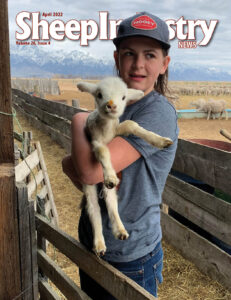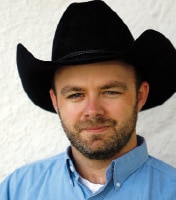JOHN WALKER, PH.D.
Texas A&M AgriLife
Targeted grazing is becoming an increasingly important sector for the American sheep industry. Recognizing the importance of this segment to the industry, ASI published the first Targeted Grazing Handbook in 2006 (SheepUSA.org/wp-content/uploads/2022/01/Targeted-Grazing-Book-compressed.pdf). Since then, targeted grazing has grown in the number of service providers, acres managed, use by land management agencies and scientific publications on the subject.
Much has been learned as a result of this growth, and because of that ASI is developing a new handbook. The goal of the new handbook is to combine the practical knowledge of producers engaged in the targeted grazing business with the latest research findings, creating a user-friendly guide for people who are new targeted graziers or contemplating starting a targeted grazing business.
To support this effort, a survey and focus group discussions with targeted grazing service providers was conducted during 2021-22. The survey had 101 respondents representing 38 different states and two Canadian provinces. In addition, six virtual focus group discussions – each with 20 or more participants – were held in January and February of this year.
On average, survey respondents’ targeted grazing experience was 8.5 years. While most of the respondents have been providing services for 10 years or less, 23 percent have practiced targeted grazing for more than 10 years and with five respondents have been in business for more than 30 years.
In terms of business opportunity, large full-time operators reported the most growth, while medium and large part-time operations tended to stay about the same size. Participants in focus groups said they had more opportunities than they could handle, indicating the opportunity for growth in the targeted grazing industry is promising.
Forty percent of operations had fewer than 20 animal unit equivalents, which is equivalent to 100 or fewer sheep. Thirty-five percent had 20 to 100 AUE and 25 percent had more than 100 AUE. On average, graziers combined two classes of livestock with the most common being hair sheep and goats.
Forty-seven percent of survey respondents were on paid projects four to five months of the year, but responses varied from only one to two months to more than eight months. Flock size tended to determine how many months were spent on grazing projects. A higher percentage of targeted graziers with large flocks provide services on a full-time basis with targeted grazing as their primary business model. However, there were significant numbers of large flocks that were less than full-time, which likely indicates that commodity production is their primary business model. In comparison, medium and small flock operators were more likely to be half or part-time.
When asked what types of landscapes survey respondents provide services for – private land rural, public land rural, urban rural interface or urban – distribution was fairly even across these disparate areas. On average respondents worked in three of the four areas, which is an indication of their ability to adapt their services to different situations.
Targeted plant species reported included 45 different problematic species. The top 10 species included woody brush and trees, broadleaf weeds, annual grasses, blackberries, thistles, multiflora rose, knapweed, kudzu, pine and leafy spurge. Woody brush and trees were the most common plants targeted grazing was used for.
The types of jobs for which targeted grazing is applied are diverse and graziers report working flocks in multiple settings. The most common targeted grazing projects are directed at controlling invasive plants, forest plantations, fuels management and open space conservation. Landfills and solar grazing projects are becoming more popular. Less well-known areas of application include wildlife habitat improvement and cover crop management, as well as orchards and vineyards. There are a host of other types of projects that primarily deal with cleaning up difficult terrains.
Pricing for services varied considerably. Sixty percent of survey respondents charge per acre for targeted grazing services, followed by per day (30 percent), and other methods (10 percent). The average low price per acre across all animal species was $650 and the average high price was $1,725. The cost varied by species of livestock used with the highest for goats – which are most often used on smaller jobs – and lowest for wool sheep and cattle. These differences – in part – reflect the difference in size of jobs and the different classes of animals. Full-time operators charged on average 45 percent more per acre than half-time operators, which were 40 percent higher than part-time operators. Prices varied regionally as well with Midwest and East Coast states charging the most. Great Plains and Upper Midwest areas charged the least and the Mountain states and West Coast were intermediate.
In targeted grazing, there is a learning curve for both graziers and livestock. On average, the number of months it took for livestock to become proficient at targeted grazing is as follows: sheep, three months; goats slightly more than two months; and cattle one and a half months. It is thought that the type of job might influence the proficiency time. Size of flock also impacts proficiency training with large and small operators reporting longer training than medium-size flocks.
When asked how livestock are kept on projects, almost 80 percent of respondents use electronic fencing. Other responses included permanent fencing, multistrand electrical fence, herders, and panels. The most important health issues that targeted graziers deal with are internal parasites, predation and toxic plants.
Although having a contract with the customer is the norm, it varies somewhat. Only 52 percent of respondents use contracts for most projects and 30 percent use contracts only when the consumer requests a contract. The new handbook will have contract samples. About half of the respondents have specific performance criteria for projects with before and after photos being the most common method for monitoring vegetation.
We can’t talk about the benefits of targeted grazing without addressing the issue of negative publicity. At least 56 percent of respondents know of targeted grazing projects that were done poorly and hurt the reputation of the industry. Thus, the impetus for writing the second edition of the Targeted Grazing Handbook.
The No. 1 response on ways to mitigate negative publicity was to “keep job site and animals in good shape.” Other responses included “talk with people who stop by and are interested in the project,” “engage the press and take interviews,” “train employees in the importance of public relations,” and prepare educational handouts.
There are many factors that targeted graziers consider when deciding whether or not to accept a targeted grazing job. The following concerns are not uncommon.
• The person or organization seeking targeted grazing has unrealistic expectations;
• The job requires more resources than are available;
• There is high potential liability exposure;
• There are conditions that put safety of livestock at risk;
• Grazing might do more damage because the source of the problem (weeds) hasn’t been addressed;
• High level of poisonous plants.
Today, we know much more about targeted grazing from both the scientific perspective and from the practical experience of targeted grazing experts. Advancing the industry from a position of both applied science and from that of the user is worth marketing. It will be fun to see how this eco-friendly livestock application will develop in the next 16 years.




